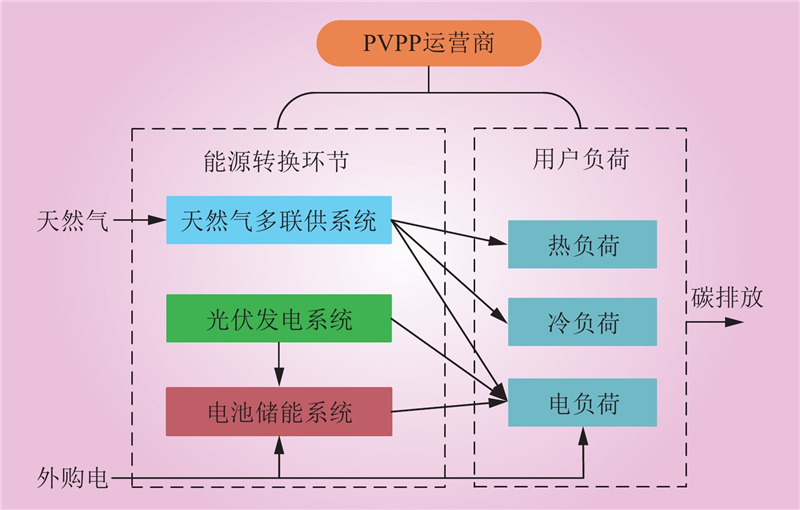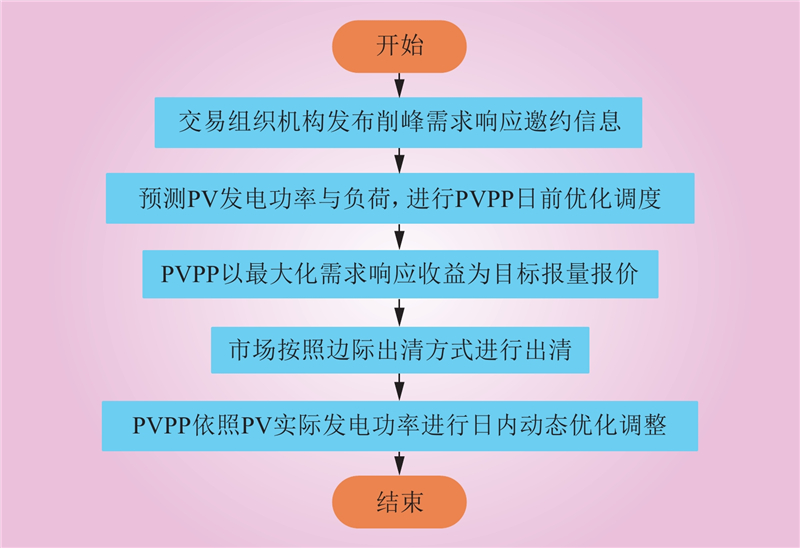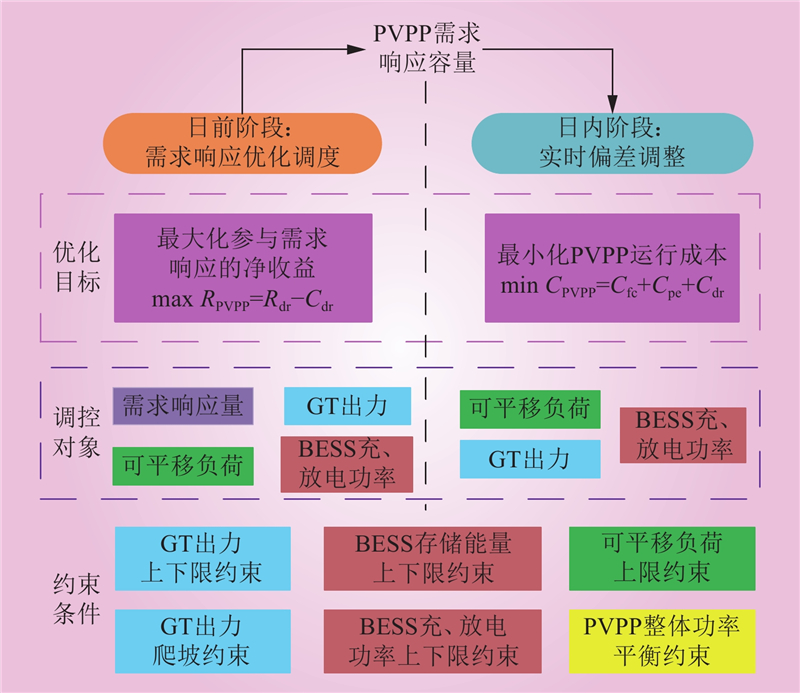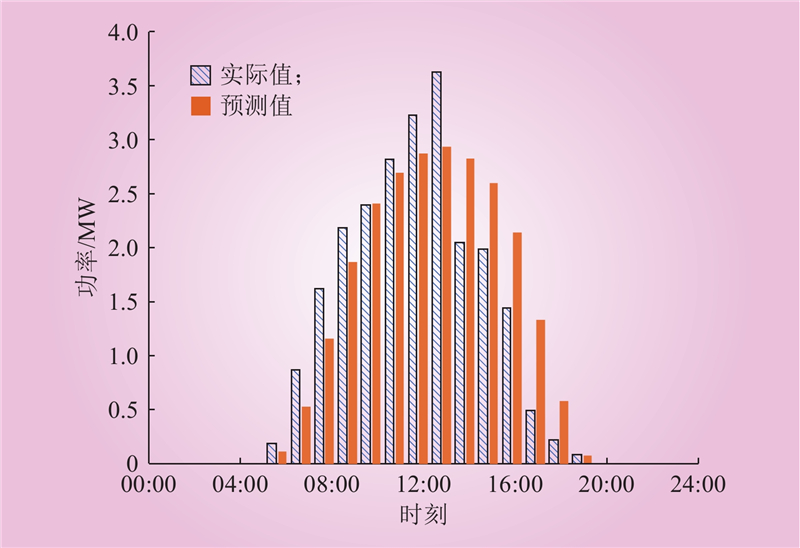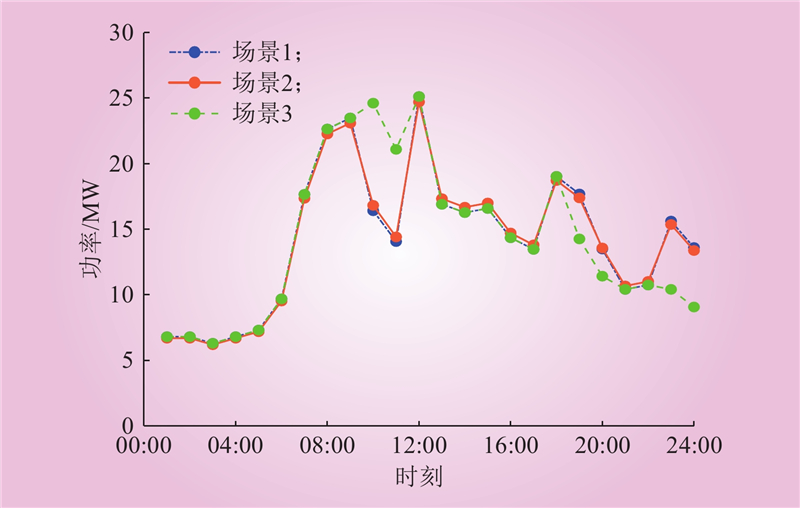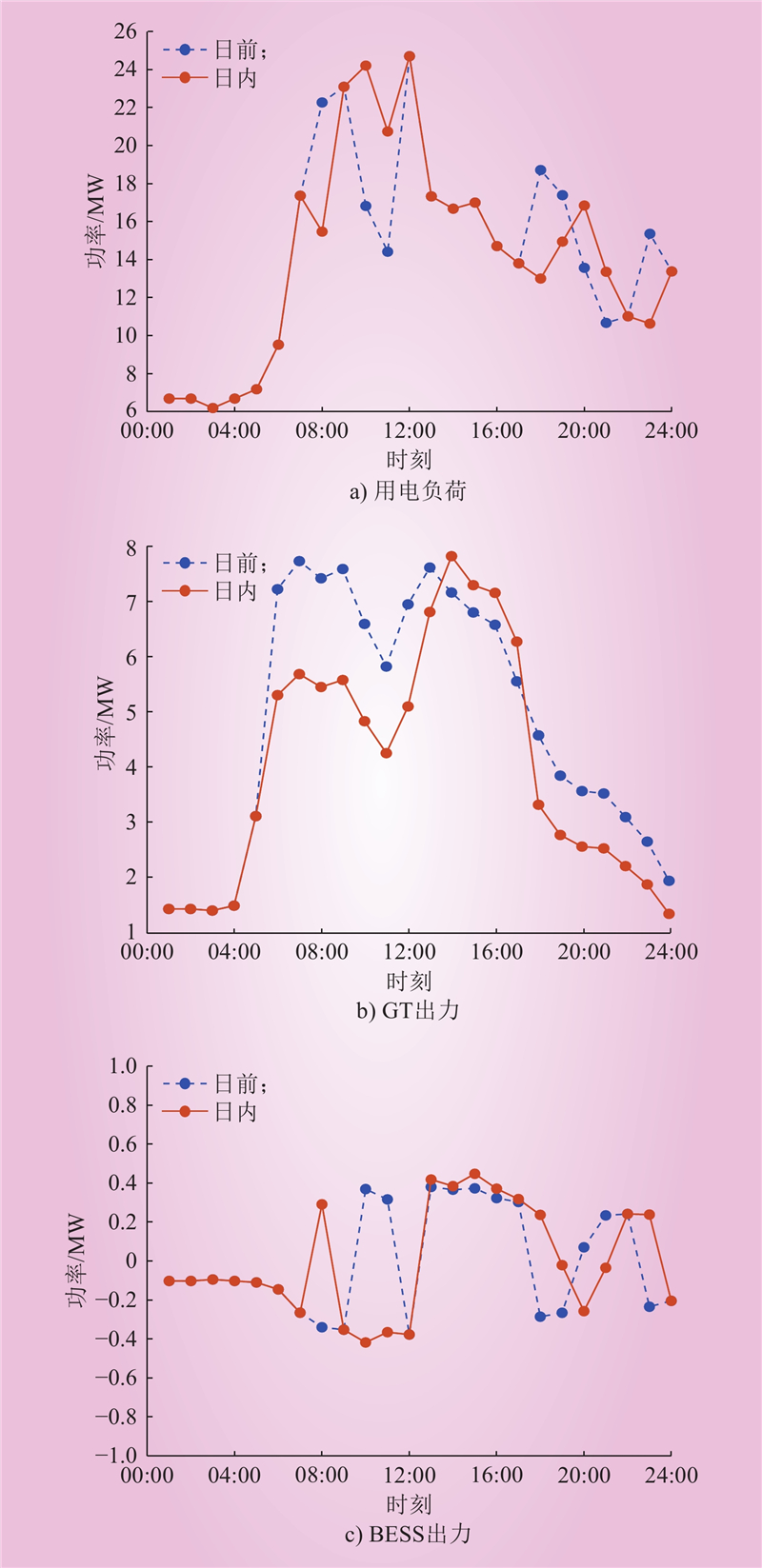| 1 |
GAO H C, JIN T, FENG C, et al. Review of virtual power plant operations: Resource coordination and multidimensional interaction[J]. Applied Energy, 2024, 357, 122284.
DOI
|
| 2 |
段贵超, 王恭, 曹生现, 等. 虚拟电厂运行策略及DG分布式控制研究[J]. 发电技术, 2024, 45 (4): 765- 771.
DOI
|
|
DUAN Guichao, WANG Gong, CAO Shengxian, et al. Research on operation strategy of virtual power plant and distributed control of DG[J]. Power Generation Technology, 2024, 45 (4): 765- 771.
DOI
|
| 3 |
傅铮, 王峰, 王若宇, 等. 基于时序生产模拟的需求侧响应促进新能源消纳量化分析[J]. 浙江电力, 2024, 43 (9): 39- 48.
|
|
FU Zheng, WANG Feng, WANG Ruoyu, et al. Quantitative analysis of renewable energy consumption promoted by demand-side response based on time-series production simulation[J]. Zhejiang Electric Power, 2024, 43 (9): 39- 48.
|
| 4 |
刘健, 刘雨鑫, 庄涵羽. 虚拟电厂关键技术及其建设实践[J]. 综合智慧能源, 2023, 45 (6): 59- 65.
|
|
LIU Jian, LIU Yuxin, ZHUANG Hanyu. Key technologies and construction practices of virtual power plants[J]. Integrated Intelligent Energy, 2023, 45 (6): 59- 65.
|
| 5 |
刘向向, 张森林, 朱思乔, 等. 基于灰靶理论和谱聚类的虚拟电厂多形态柔性资源聚合模型[J]. 中国电力, 2023, 56 (11): 104- 112.
DOI
|
|
LIU Xiangxiang, ZHANG Senlin, ZHU Siqiao, et al. Multi-form flexible resource aggregation model for virtual power plant based on grey target theory and spectral clustering[J]. Electric Power, 2023, 56 (11): 104- 112.
DOI
|
| 6 |
姜立兵, 刘念, 庞万, 等. 计及碳交易和需求响应的虚拟电厂低碳经济运行分析[J]. 内蒙古电力技术, 2024, 42 (5): 28- 37.
|
|
JIANG Libing, LIU Nian, PANG Wan, et al. Analysis of low carbon economic operation of virtual power plants considering carbon trading and demand response[J]. Inner Mongolia Electric Power, 2024, 42 (5): 28- 37.
|
| 7 |
陈张宇, 刘东, 刘浩文, 等. 基于精细化需求响应的虚拟电厂优化调度[J]. 电网技术, 2021, 45 (7): 2542- 2550.
|
|
CHEN Zhangyu, LIU Dong, LIU Haowen, et al. Optimal dispatching of virtual power plant based on refined demand response[J]. Power System Technology, 2021, 45 (7): 2542- 2550.
|
| 8 |
潘明杰, 解大, 王西田. 计及分布式资源调节特性差异的虚拟电厂响应策略[J]. 电力系统自动化, 2022, 46 (18): 108- 117.
DOI
|
|
PAN Mingjie, XIE Da, WANG Xitian. Response strategy for virtual power plant considering difference in regulation characteristics of distributed energy resources[J]. Automation of Electric Power Systems, 2022, 46 (18): 108- 117.
DOI
|
| 9 |
黄蔚亮, 苏志鹏, 梁欣怡, 等. 考虑可调市场和外部需求响应的虚拟电厂优化运行策略[J]. 中国电力, 2023, 56 (12): 156- 163.
DOI
|
|
HUANG Weiliang, SU Zhipeng, LIANG Xinyi, et al. Optimal operation strategy for virtual power plant considering regulation market and external demand response[J]. Electric Power, 2023, 56 (12): 156- 163.
DOI
|
| 10 |
葛鑫鑫, 付志扬, 徐飞, 等. 面向新型电力系统的虚拟电厂商业模式与关键技术[J]. 电力系统自动化, 2022, 46 (18): 129- 146.
DOI
|
|
GE Xinxin, FU Zhiyang, XU Fei, et al. Business model and key technologies of virtual power plant for new power system[J]. Automation of Electric Power Systems, 2022, 46 (18): 129- 146.
DOI
|
| 11 |
YANG D C, HE S W, CHEN Q Y, et al. Bidding strategy of a virtual power plant considering carbon-electricity trading[J]. CSEE Journal of Power and Energy Systems, 2019, 5 (3): 306- 314.
|
| 12 |
艾星贝, 闫庆友, 李金孟. 考虑负荷平移的虚拟电厂低碳经济调度[J]. 科学技术与工程, 2022, 22 (26): 11418- 11427.
|
|
AI Xingbei, YAN Qingyou, LI Jinmeng. Low carbon economy dispatching of virtual power plant considering load shifting[J]. Science Technology and Engineering, 2022, 22 (26): 11418- 11427.
|
| 13 |
魏震波, 孙舟倍, 梁政. 基于多目标两阶段规划的虚拟电厂优化调度[J]. 南方电网技术, 2023, 17 (4): 109- 118.
|
|
WEI Zhenbo, SUN Zhoubei, LIANG Zheng. Virtual power plant optimal dispatching based on multi-objective and two-stage programming[J]. Southern Power System Technology, 2023, 17 (4): 109- 118.
|
| 14 |
苏志鹏, 王莉, 梁欣怡, 等. 考虑阶梯式碳交易及综合需求响应的虚拟电厂优化调度[J]. 中国电力, 2023, 56 (12): 174- 182.
DOI
|
|
SU Zhipeng, WANG Li, LIANG Xinyi, et al. Optimal dispatch of virtual power plant considering stepped carbon trading and comprehensive demand response[J]. Electric Power, 2023, 56 (12): 174- 182.
DOI
|
| 15 |
LIANG Z M, ALSAFASFEH Q, JIN T, et al. Risk-constrained optimal energy management for virtual power plants considering correlated demand response[J]. IEEE Transactions on Smart Grid, 2019, 10 (2): 1577- 1587.
DOI
|
| 16 |
林毓军, 苗世洪, 杨炜晨, 等. 面向多重不确定性环境的虚拟电厂日前优化调度策略[J]. 电力自动化设备, 2021, 41 (12): 143- 150.
|
|
LIN Yujun, MIAO Shihong, YANG Weichen, et al. Day-ahead optimal scheduling strategy of virtual power plant for environment with multiple uncertainties[J]. Electric Power Automation Equipment, 2021, 41 (12): 143- 150.
|
| 17 |
李东东, 王啸林, 沈运帷, 等. 考虑多重不确定性的含需求响应及电碳交易的虚拟电厂优化调度策略[J]. 电力自动化设备, 2023, 43 (5): 210- 217, 251.
|
|
LI Dongdong, WANG Xiaolin, SHEN Yunwei, et al. Optimal scheduling strategy of virtual power plant with demand response and electricity-carbon trading considering multiple uncertainties[J]. Electric Power Automation Equipment, 2023, 43 (5): 210- 217, 251.
|
| 18 |
廖思阳, 贺聪, 李玲芳, 等. 考虑电力网络约束的工业园区虚拟电厂调控边界求解方法[J]. 电力系统自动化, 2024, 48 (18): 66- 75.
|
|
LIAO Siyang, HE Cong, LI Lingfang, et al. Solution method of regulation boundary for industrial park virtual power plant considering power network constraints[J]. Automation of Electric Power Systems, 2024, 48 (18): 66- 75.
|
| 19 |
赵昊天, 王彬, 潘昭光, 等. 支撑云-群-端协同调度的多能园区虚拟电厂: 研发与应用[J]. 电力系统自动化, 2021, 45 (5): 111- 121.
|
|
ZHAO Haotian, WANG Bin, PAN Zhaoguang, et al. Research and application of park-level multi-energy virtual power plants supporting cloud-cluster-end multi-level synergetic dispatch[J]. Automation of Electric Power Systems, 2021, 45 (5): 111- 121.
|
| 20 |
田壁源, 常喜强, 戚红燕, 等. 基于混合博弈的园区虚拟电厂广义储能共享与协同优化调度[J]. 电力需求侧管理, 2023, 25 (4): 8- 14.
DOI
|
|
TIAN Biyuan, CHANG Xiqiang, QI Hongyan, et al. Generalized energy storage sharing and collaborative optimal scheduling of park-level vritual power plants based on mixed game[J]. Power Demand Side Management, 2023, 25 (4): 8- 14.
DOI
|
| 21 |
DENG Y F, JIANG W, XU J J, et al. Data-driven park-level virtual power plant self-scheduling based on the quarterly budget and the corrected conditional expectation[J]. IEEE Transactions on Industry Applications, 2025, 61 (1): 1442- 1454.
DOI
|
| 22 |
林沛昕. 面向园区最优用能的分布式光伏及储能容量配置方法[J]. 东北电力大学学报, 2024, 44 (5): 50- 56.
|
|
LIN Peixin. Distributed photovoltaic and energy storage capacity allocation method for the optimal use of energy in the park[J]. Journal of Northeast Electric Power University, 2024, 44 (5): 50- 56.
|
| 23 |
呼斯乐, 于源, 王渊, 等. 考虑灵活性分析的典型光伏日出力率曲线提取方法[J]. 内蒙古电力技术, 2024, 42 (3): 20- 27.
|
|
HU Sile, YU Yuan, WANG Yuan, et al. Method for extracting typical PV daily output curves considering flexibility analysis[J]. Inner Mongolia Electric Power, 2024, 42 (3): 20- 27.
|
| 24 |
柳旭, 陆俊, 龚钢军, 等. 面向光伏数据采集与存储的安全防护方法[J]. 综合智慧能源, 2024, 46 (5): 73- 80.
DOI
|
|
LIU Xu, LU Jun, GONG Gangjun, et al. Security protection for photovoltaic data acquisition and storage[J]. Integrated Intelligent Energy, 2024, 46 (5): 73- 80.
DOI
|
| 25 |
黄南天, 郭玉, 赵暄远. 计及辐照区间划分的含光伏电源配电网源-荷联合场景生成[J]. 东北电力大学学报, 2023, 43 (5): 78- 84.
|
|
HUANG Nantian, GUO Yu, ZHAO Xuanyuan. Combined source-load scenario generation for PV-containing distribution networks with calculation andirradiation interval classification[J]. Journal of Northeast Electric Power University, 2023, 43 (5): 78- 84.
|
| 26 |
杨彪, 颜伟, 莫静山. 考虑源荷功率随机性和相关性的主导节点选择与无功分区方法[J]. 电力系统自动化, 2021, 45 (11): 61- 67.
|
|
YANG Biao, YAN Wei, MO Jingshan. Pilot-bus selection and network partitioning method considering randomness and correlation of source-load power[J]. Automation of Electric Power Systems, 2021, 45 (11): 61- 67.
|
| 27 |
徐恒辉, 姚杰, 周萍, 等. 基于运行数据的光伏电站状态评估方法研究[J]. 电力科技与环保, 2023, 39 (5): 450- 456.
|
|
XU Henghui, YAO Jie, ZHOU Ping, et al. Research on photovoltaic power plant state evaluation based on operating data[J]. Electric Power Technology and Environmental Protection, 2023, 39 (5): 450- 456.
|
| 28 |
杨康, 李蓝青, 李艺丰, 等. 一种新型分布式光伏出力区间预测方法[J]. 发电技术, 2024, 45 (4): 684- 695.
DOI
|
|
YANG Kang, LI Lanqing, LI Yifeng, et al. A novel distributed photovoltaic output interval prediction method[J]. Power Generation Technology, 2024, 45 (4): 684- 695.
DOI
|
| 29 |
周洋, 黄德志, 李培栋, 等. 考虑平衡端点相位不对称及光伏接入的低压配电网三相潮流模型[J]. 中国电力, 2024, 57 (10): 190- 198.
DOI
|
|
ZHOU Yang, HUANG Dezhi, LI Peidong, et al. A three-phase power flow model for low-voltage distribution networks considering balanced bus phase asymmetry and photovoltaic access[J]. Electric Power, 2024, 57 (10): 190- 198.
DOI
|
| 30 |
钱乙卫, 田浩, 刘财华, 等. 考虑概率分布的分布式光伏无功下垂控制策略[J]. 发电技术, 2024, 45 (2): 273- 281.
DOI
|
|
QIAN Yiwei, TIAN Hao, LIU Caihua, et al. Droop control strategy of distributed photovoltaic reactive power considering probability distribution[J]. Power Generation Technology, 2024, 45 (2): 273- 281.
DOI
|
| 31 |
刘衣萍, 于鹤洋, 王晨旭, 等. 考虑用户行为的居民空调负荷需求响应[J]. 浙江电力, 2023, 42 (3): 1- 8.
|
|
LIU Yiping, YU Heyang, WANG Chenxu, et al. Demand response of residential air conditioning load based on user behavior[J]. Zhejiang Electric Power, 2023, 42 (3): 1- 8.
|
| 32 |
鲍海波, 梁浚杰, 李想. 园区供电系统广义负荷需求响应建模与分析[J]. 综合智慧能源, 2024, 46 (1): 11- 17.
|
|
BAO Haibo, LIANG Junjie, LI Xiang. Modeling and analysis on demand response for generalized load of power supply systems in industrial parks[J]. Integrated Intelligent Energy, 2024, 46 (1): 11- 17.
|
| 33 |
祁兵, 陈淑娇, 李彬, 等. 计及用户满意度的可调节负荷资源需求响应优化策略研究[J]. 内蒙古电力技术, 2023, 41 (3): 43- 50.
|
|
QI Bing, CHEN Shujiao, LI Bin, et al. Research on demand response optimization strategy of adjustable load resource considering user satisfaction[J]. Inner Mongolia Electric Power, 2023, 41 (3): 43- 50.
|
| 34 |
王宏, 宋禹飞, 刘润鹏, 等. 虚拟电厂标准化现状与需求分析[J]. 浙江电力, 2024, 43 (5): 1- 9.
|
|
WANG Hong, SONG Yufei, LIU Runpeng, et al. Current status and demand analysis of virtual power plant standardization[J]. Zhejiang Electric Power, 2024, 43 (5): 1- 9.
|
| 35 |
呼斯乐, 王渊, 于源, 等. 考虑风光不确定性与灵活性指标的园区综合能源系统最优调度[J]. 内蒙古电力技术, 2024, 42 (1): 15- 21.
|
|
HU Sile, WANG Yuan, YU Yuan, et al. Optimal dispatching of integrated energy system in industrial parks considering wind and solar uncertainty and flexibility indicators[J]. Inner Mongolia Electric Power, 2024, 42 (1): 15- 21.
|
| 36 |
曹紫霖, 王文静, 赵薇, 等. 考虑需求响应的负荷密集区分布式综合能源系统优化调度研究[J]. 综合智慧能源, 2023, 45 (7): 11- 21.
|
|
CAO Zilin, WANG Wenjing, ZHAO Wei, et al. Research on optimal scheduling of distributed integrated energy systems in load-intensive areas considering demand response[J]. Integrated Intelligent Energy, 2023, 45 (7): 11- 21.
|
| 37 |
张波, 胡卫军, 王健, 等. 面向虚拟电厂的需求响应潜力评估方法研究[J]. 浙江电力, 2023, 42 (6): 78- 85.
|
|
ZHANG Bo, HU Weijun, WANG Jian, et al. Research on a demand response potential evaluation method for virtual power plant[J]. Zhejiang Electric Power, 2023, 42 (6): 78- 85.
|


